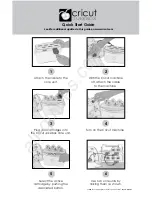
NAMES OF MACHINE PARTS AND THEIR FUNCTIONS
15
The names of the various parts of the sewing machine and their functions are described below. Before
using the sewing machine, carefully read these descriptions to learn the names of the machine parts.
Machine
■
Front View
a
Top cover
Open the top cover when threading the machine or winding the
bobbin.
b
Pre-tension disk
Pass the thread around the pre-tension disk when winding the
bobbin thread. (page 54)
c
Thread guide for bobbin winding
Pass the thread through this thread guide when winding the
bobbin thread. (page 54)
d
Spool pin
Place a spool of thread on the spool pin. (page 62)
e
Spool cap
Use the spool cap to hold the spool of thread in place. (page
62)
f
Supplemental spool pin
Use this spool pin to wind the bobbin thread, or to sew with the
twin needle. (page 54, 65)
g
Bobbin winder
Use the bobbin winder when winding the bobbin. (page 54)
h
LCD (liquid crystal display)
Settings for the selected stitch and error messages appear in
the LCD. (page 32)
i
Speaker
j
Knee lifter
Use the knee lifter to raise and lower the presser foot. (page 96)
k
Knee lifter slot
Insert the knee lifter into the slot. (page 96)
l
Operation buttons (7 buttons) and sewing speed
controller
Use these buttons and the slide to operate the sewing
machine. (page 17)
m
Flat bed attachment with accessory compartment
Store presser feet and bobbins in the accessory compartment
of the flat bed attachment. When sewing cylindrical pieces,
remove the flat bed attachment. (page 18)
n
Thread cutter
Pass the threads through the thread cutter to cut them. (page
64)
o
Thread guide plate
Pass the thread around the thread guide plate when threading
upper thread. (page 62)
■
Right-side/Rear View
a
Connector for the presser foot
Connect the dual feed foot or embroidery foot with LED
pointer. (page 72, 211)
b
Handle
Carry the sewing machine by its handle when transporting the
machine.
c
Presser foot lever
Raise and lower the presser foot lever to raise and lower the
presser foot. (page 70)
d
Air vent
The air vent allows the air surrounding the motor to circulate.
Do not cover the air vent while the sewing machine is being
used.
e
Main power switch
Use the main power switch to turn the sewing machine ON and
OFF. (page 30)
f
Multi-function foot controller
Various sewing machine operations can be programmed into
the multi-function foot controller. For some countries and
areas, normal foot controller is included with the machine.
g
Power cord receptacle
Insert the power cord into the machine receptacle. (page 30)
h
Sensor pen holder connector
Connect the included sensor pen holder. (page 51)
i
Sensor pen jack
Connect the sensor pen. (page 50)
j
Foot controller jack
Insert the foot controller plug into its jack on the machine.
(page 83)
k
Headphones or external speaker jack
Connect the headphone.
l
USB port for computer
In order to import/export patterns between a computer and the
machine, plug the USB cable into the USB port. (page 48, 189,
191, 194, 222, 298, 314, 403)
m
USB port for mouse (page 48)
n
USB port
In order to send patterns from/to USB media, plug the USB
media directly into the USB port. (page 36, 48,189,190, 193,
221, 239, 288, 298, 313, 402)
o
Handwheel
Rotate the handwheel toward you (counterclockwise) to raise
and lower the needle. The wheel should be turned toward the
front of the machine.
NAMES OF MACHINE PARTS AND THEIR FUNCTIONS
Summary of Contents for 82-W20
Page 2: ......
Page 30: ...NAMES OF MACHINE PARTS AND THEIR FUNCTIONS 28 ...
Page 82: ...NEEDLE CALIBRATION USING THE BUILT IN CAMERA 80 ...
Page 170: ...SEWING THE STITCHES 168 ...
Page 190: ...COMBINING STITCH PATTERNS 188 Press Press ...
Page 198: ...USING THE MEMORY FUNCTION 196 ...
Page 210: ...USING STORED CUSTOM STITCHES 208 ...
Page 264: ...ATTACHING THE EMBROIDERY FRAME 262 b Pull the embroidery frame toward you ...
Page 286: ...ADJUSTMENTS DURING THE EMBROIDERY PROCESS 284 ...
Page 338: ...RESUME FEATURE 336 ...
Page 362: ...ILLUSTRATION SCAN 360 ...
Page 418: ......
Page 419: ......
















































